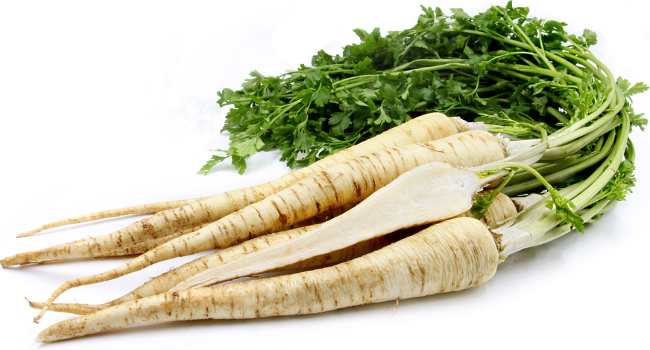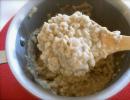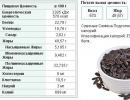Parsley medicinal properties and contraindications
Today, not many people know that parsley was originally used as a medicinal plant, and not as a spicy herb. It is still highly valued today not only for the taste that it gives to culinary dishes, but also for its healing properties. It is worth dwelling in more detail on the medicinal properties of this familiar herb.
If we consider parsley in terms of its health benefits, then all its parts: leaves, stems, root, seeds can be used to maintain your body.
What does parsley look like and grow?
Parsley is a biennial plant belonging to the Umbelliferae family. It is easy to grow and, although it is a biennial plant, it is grown as an herb in an annual crop. In the second year, the plant blooms and produces seeds, which, falling to the ground, germinate in the spring of the following year.
Depending on the variety, it can grow up to 30-60 centimeters and above. Small double pinnate green leaves are located on a straight stem. Yellowish-greenish small flowers appear on long hollow stems. The seeds formed after flowering are small and crumble easily.
Southwest Asia and the south of the Mediterranean are considered to be the original homeland, where it can still be found in the wild today. It came to us only in the 11th century and was used only for medicinal purposes.
Currently, parsley is cultivated throughout the world as a spice. Its leaves, roots, seeds give a special flavor to dishes.
What is useful parsley chemical composition
All parts of the plant contain valuable volatile oils and flavonoids. The most valuable chemical compounds of parsley are:
Glycoside apiin;
Essential oil;
Furanocoumarins;
Carotenoids;
vitamins;
mineral salts;
pectin substances;
Carbohydrates;
organic acids;
Flavonoids.
By the amount of vitamins, it is not inferior to many fruits and vegetables. In addition to the high content of vitamin C (ascorbic acid), it contains a number of B vitamins: B1, B2, B3, B5, vitamin A, K. The seeds contain vitamin E.
Mineral compounds are represented by:
Phosphorus;
calcium;
manganese;
Most of the essential oil is found in the seeds (from 2 to 6%), but it is also found in other parts of the plant. The oil content depends on the growing conditions and location. It contains such valuable compounds as:
Apiol (phenylpropanoid);
Myristicin;
and other chemical compounds. Apiol and myristicin give the greatest healing properties to the oil. The latter has chemoprotective properties. This means that it can act on cancer cells, preventing their growth. 
Flavonoids contained in parsley, such as apigenin, luteolin, act as antioxidants, which increase the body's defense against the oxidative effects of free radicals.
The seeds of the plant contain up to 22 percent fatty oil, which is represented by:
Oleic;
Linoleic;
Stearic;
palmitic;
Petroselin
fatty acids.
Mucus was found in parsley root, apigenin is a bioflavonoid that has calming properties and relieves anxiety.
Vitamin K is vital for the skeletal system, protects against osteoporosis, and is very beneficial for the circulatory and nervous systems.
Just 5 grams of parsley can provide the body with the daily requirement of vitamin A, and 25 grams of the herb can provide the daily requirement of vitamin C.
Parsley is a great source of dietary fiber as well as calcium, which can be helpful for those who don't like or tolerate dairy.
Furanocoumarins, which are found in the leaves of the plant, have antimicrobial properties. Given that it contains antioxidants, carotenoids, vitamin C, this makes it a useful herb for strengthening the immune system and increasing the body's resistance to disease.
Since the fresh herb contains iron and vitamin C, which increases the absorption of iron, it may serve to prevent anemia to some extent. In addition, it contains folic acid, which is involved in the production of red blood cells.
Some studies note the ability of parsley to limit the effects of certain carcinogens. Scientists attribute this to the presence of chlorophyll. But the antioxidant compounds and other substances contained in this herb also have an effect on this.
The use of parsley stimulates digestion, improves the absorption of nutrients and reduces the likelihood of gas formation in the intestines. No wonder in some countries parsley is always served at the table.
As a vegetable product, its calorie content is low and is only 36 calories per 100 grams.
parsley medicinal properties
Due to its unique chemical composition, it was not for nothing that parsley was originally used as a medicinal plant. It has many medicinal properties:
Anti-inflammatory;
Antibacterial;
Antioxidant;
painkillers;
Hemostatic;
Vascular strengthening;
Wound healing;
bactericidal;
Cholagogue;
Diuretic;
Antiseptic;
Tonic.
Parsley can be used as a remedy:
Strengthening blood vessels and capillaries;
Normalizing the work of the thyroid gland and adrenal cortex;
For the prevention and treatment of bladder infections;
From bad breath;
Normalization and stimulation of digestion;
Increase in appetite;
Tonic and cleansing blood vessels;
To reduce the formation of gases in the intestines and relieve spasm;
To save vision;
Improving metabolic processes;
To restore performance and tone.
Parsley preparations are taken for the treatment of:
Urolithiasis;
Liver diseases;
Gallbladder;
renal colic;
prostate;
Dyspepsia;
flatulence;
Menstrual irregularities;
Uterine bleeding.
A decoction or juice of parsley is traditionally used to lighten age spots. Fresh juice well relieves itching and irritation from insect bites, reduces swelling.
In breastfeeding women, it can improve the production of breast milk.
Since parsley dissolves salts well, it is indicated for the prevention and treatment of atherosclerosis. 
parsley leaves
Parsley leaves have diuretic properties due to the presence of flavonoids, essential oil and potassium salts in them. The constituent of the essential oil apiol or parsley camphor improves digestion, gives antispasmodic, vasodilating and blood circulation properties. It should be noted that all this is enhanced by the action of myristicin.
Due to the high content of vitamins, mineral salts and other useful substances in parsley leaves, they have tonic properties, replenish the body with nutrients, and prevent anemia.
Chewing parsley leaves can help, if not completely eliminate, then reduce the smell of garlic from the mouth.
Infusion, decoction, leaf juice is used in cosmetology for dark circles under the eyes, reducing pigmentation.
parsley root
Parsley root has milder diuretic properties than seeds or leaves. It can be taken with:
Recovery after illness;
poor appetite;
Dyspepsia;
flatulence;
urethritis;
Urolithiasis;
Edema and obesity, accompanied by fluid retention;
Parsley decoction
Parsley decoction is most often taken as a diuretic. You can prepare a decoction from the leaves, stems, seeds or roots of the plant. Parsley roots have stronger diuretic properties.
To prepare a decoction, take:
Parsley root (chopped) - 1.5 teaspoons
Water - 250 ml
Pour hot water over the parsley root and put on the stove over low heat and boil for 5-7 minutes.
Remove and let steep for another 30 minutes. Then strain and take as directed.
A decoction of the leaves is prepared in a similar way. To prepare it, take:
Fresh leaves - 25 grams
Water - 250 ml
Wash the leaves well and pat dry. Cut and pour hot water. Put the container on the stove and boil at a low boil for 5-7 minutes. Cool slightly and filter. You can cook the broth in a water bath, holding the container for 10-15 minutes.
Parsley infusion
Parsley infusion is used as a diuretic, to relieve swelling, and as a skin care lotion.
To prepare the infusion, take:
2 tablespoons of chopped herb or root and pour a glass of boiling water. Insist and filter.
An infusion can be made from the green part of the plant and the seeds. To prepare it, take 1 teaspoon of herbs and seeds and brew with a glass of boiling water. Infuse for 10 minutes and filtered, take a glass three times a day.
A stronger infusion can be obtained if, after brewing, boil over low heat for 5 minutes and let it brew for another 15 minutes.
Take 1 glass three times a day before meals.
Parsley tincture
Parsley tincture on vodka or alcohol can be taken to improve and normalize digestion, from a headache. Prepare it in a ratio of 1 part of the raw materials take 10 or 5 parts of vodka.
Infuse in a dark place for 14-16 days and filter.
For headaches, the tincture is taken 5-7 drops diluted with water three times a day before meals.
To improve digestion, increase appetite - from 10 to 30 drops three, four times a day before meals, which must also be diluted with water before taking.
Parsley contraindications and side effects
There are no contraindications to the use of parsley, except for individual intolerance. But that's the case when it comes to its use as a culinary herb. When it comes to treatment, it is not for everyone.
Parsley seeds and essential oil should not be used in large doses, as they are toxic. Therefore, when treating with such drugs, it is necessary to strictly observe the dosage and rules of use.
Do not use seeds and essential oil to treat people with kidney diseases, such as nephritis. Also, such drugs can cause irritation of the stomach, problems with the liver, heart.
Herbal tea with parsley should not be drunk for more than two weeks.
It is always best to consult your doctor before starting treatment.
Learn more about the health benefits of parsley





